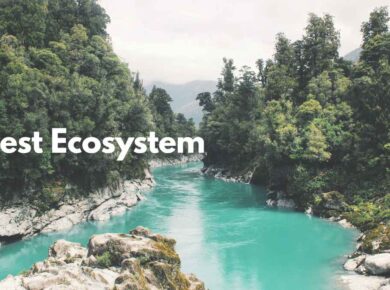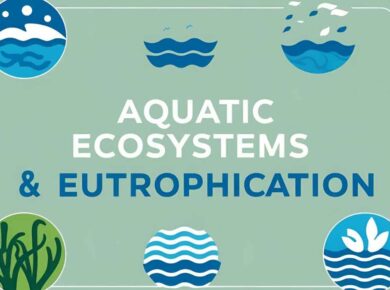Different types of Species
Keystone species
Species which determine the ability of a large number of other species to survive. Extinction of keystone species has snowballing effect on extinction of other species.
Examples of keystone species: Bees > pollination of fruits and flowers, Plankton > food of many fishes
Flagship species
- a species selected to act as an icon or symbol for a defined habitat campaign or environmental cause
- By focusing on, and achieving conservation of that species, the status of many other species which share its habitat – or are vulnerable to the same threats – may also be improved.
Umbrella species
- Species selected for making conservation related decisions
- Typically because protecting these species indirectly protects the many other species that make up the ecological community of its habitat
Indicator species
- a species or group of species chosen as an indicator of the state of an ecosystem or of certain processes within that ecosystem.
- can be among the most sensitive species in a region, and sometimes act as an early warning to monitoring biologists
Charismatic megafauna
- large animal species with widespread popular appeal
- environmental activists uses them to achieve environmentalist goals
Sentinel species
- Species which are sensitive indicator of environmental problems. For ex. frogs, toads, salamander, vultures
- Frogs breath through their moist skin, which is very sensitive to pollutants in environment
- a rapid decline in the population of frogs thus would indicate a looming environmental problem.
Non-native species
- Non-native species have no predators or competitors to control their population in new area hence they destroy a vast range of plants & reduced the forest area.
- Rats of several species were unintended stowaways on oceanic voyages, and thus spread around the world.
- Infected humans took human immunodeficiency virus (HIV), which caused aids from Africa to the rest of the world.
Sacred Groves of India
- Communally + NGO protected forests which usually have a significant religious connotation for the protecting community for ex. Myristica swaps of Kerala
- Their water holding capacity is immense and thus their depletion can lead to floods in rains and dry valley in other seasons
- Hunting and logging are usually strictly prohibited but other forms of forest usage like honey collection and deadwood collection are sometimes allowed on a sustainable basis.
- Sacred groves did not enjoy legal protection in India until the introduction of the protected area category community reserves under the Wildlife (Protection) Amendment Act of 2002.
Vultures and Diclofenac
- Diclofenac is a painkiller medicine used mostly for arthritis in humans & Veterinary Diclofenac is used on cattle, as painkiller, stopping inflammation and fever
- When Animals are treated with Diclofenac, this drug keeps accumulating in their body. When these animals die, Vultures eat them – kidney failure – death of vulture
- Less vultures – more dead animals for dogs to eat – dog population increases – more problem of rabies.
- Vulture’s digestive system can destroy many parasites, but dog’s digestive system cannot. Hence dogs who eat dead animals are more disease carriers than vultures
- Hence Government of India banned veterinary Diclofenac, now farmers use Meloxicam drugs instead of Diclofenac.
Blue whales
- Largest mammals on Earth (Elephents are the largest mammals on land only)
- International whaling commission (IWC) was set up in 1946 to fix hunting quota of whales for the countries but Since 1980s IWC called for a halt on whale poaching
- Japan, Norway and Ireland are major countries that still continue to indulge in whale hunting & are unhappy with IWC and CITES restrictions.
Warm blooded animals
- have a body temperature that stays constant no matter what the outside temperature is;
- they have to take in a lot of food every day to create enough energy to maintain that temperature.
- Birds, Mammals
Cold-blooded animals
- have a body temperature that changes depending on the temperature of their surroundings.
- Cold-blooded animals are more active when the temperature is warm.
- In colder temperatures, they become sluggish, sometimes going into a sleep-like state called dormancy.
- Because they don’t have to maintain a steady body temperature, cold-blooded animals can go much longer without food than warm-blooded animal
- Fishes, amphibians & reptiles
Vertebrate
- an animal that has a spine, or backbone
- mammals, birds, reptiles, amphibians, and fishes
- are the most advanced organisms on Earth
Invertebrates
- animals that do not have backbones, such as insects like butterflies and grasshoppers, spiders, and worms.
- Most of the animals on Earth are actually invertebrates, comprising 95 per cent of animal species.
Mammals
- warm blooded vertebrate animal, distinguished by the possession of hair or fur
- females secrete milk for the nourishment of the young
- Humans, whales, elephants, horses, dogs, bats
Amphibians
- cold-blooded vertebrates that live on land and in water,
- fertilization is typically external, meaning that the sperm and egg join outside of the female’s body,
- lay unprotected eggs (without shell like chicken egg) in water or moist damp places
- Frogs, toads, salamanders, Caecilians, newts
Reptiles
- Cold blooded vertebrates whose bodies are covered by scales.
- Most reptiles lay eggs, similar to birds. Many reptiles do not look after their offspring.
- Unlike mammal’s offspring, young reptiles are equipped to survive without parental care
- snakes, crocodiles and alligators, turtles, chameleon, lizards
Anarchids
- invertebrate characterized by simple eyes and four pairs of legs
- spiders, scorpions, ticks, mites, harvestmen
Mollusk
- an invertebrate of a large phylum which includes snails, slugs, mussels, Squids and octopuses.
- They have a soft body & live in aquatic or damp habitats, and most kinds have an external calcareous shell.
Bacteria
- Non chlorophylls microorganisms which lead saprophytic or parasitic existence

Algae
- Green non-differentiated plant (non-differentiated into organs like root, stem & leaf) possessing chlorophyll,
- generally, grow in moist conditions (Autotrophic plants i.e. can manufacture their own food)
Fungi
- Non green, non-differentiated plant characterized by total absence of chlorophyll,
- grow either on dead, rotten organic matters as saprophytes or live as parasites on other living bodies (referred as hosts) ex. Mushroom & Mould
Lichens
- A peculiar combination of an algae & a fungus (Greyish green plants)
- Lives in symbiosis as algae produce carbohydrates for fungus & fungus absorbs & retains water, keeping algal cell moist.
If you’re passionate about building a successful blogging website, check out this helpful guide at Coding Tag – How to Start a Successful Blog. It offers practical steps and expert tips to kickstart your blogging journey!
For dedicated UPSC exam preparation, we highly recommend visiting www.iasmania.com. It offers well-structured resources, current affairs, and subject-wise notes tailored specifically for aspirants. Start your journey today!







